- General Top
- SEMICONDUCTOR
- STORAGE
- COMPANY
-
My ToshibaSemicon
- Semiconductor Top
-
ApplicationsAutomotive
Body Electronics
xEV
In-Vehicle Infotainment
Advanced Driver-Assistance Systems (ADAS)
Chassis
IndustrialInfrastructure
BEMS/HEMS
Factory Automation
Commercial Equipment
Consumer/PersonalIoT Equipment
Healthcare
Wearable Device
Mobile
Computer Peripherals
-
ProductsAutomotive Devices
Discrete Semiconductor
Diodes
Transistors
Logic ICs
Analog Devices
Digital Devices
Wireless Devices
※
: Products list (parametric search)
Power SemiconductorsSiC Power Devices
※
: Products list (parametric search)
Isolators/Solid State RelaysPhotocouplers
Digital Isolators
Solid State Relays
Fiber Optic Transmitting Modules
※
: Products list (parametric search)
MOSFETsIGBTs/IEGTsBipolar Transistors※
: Products list (parametric search)
Diodes※
: Products list (parametric search)
MicrocontrollersMotor Driver ICsIntelligent Power ICs※
: Products list (parametric search)
Power Management ICsLinear ICs※
: Products list (parametric search)
General Purpose Logic ICsLinear Image SensorsOther Product ICsOther Product ICs
※
: Products list (parametric search)
-
Design & Development
-
Knowledge
- Where To Buy
- Part Number & Keyword Search
- Cross Reference Search
- Parametric Search
- Stock Check & Purchase
This webpage doesn't work with Internet Explorer. Please use the latest version of Google Chrome, Microsoft Edge, Mozilla Firefox or Safari.
require 3 characters or more. Search for multiple part numbers fromhere.
The information presented in this cross reference is based on TOSHIBA's selection criteria and should be treated as a suggestion only. Please carefully review the latest versions of all relevant information on the TOSHIBA products, including without limitation data sheets and validate all operating parameters of the TOSHIBA products to ensure that the suggested TOSHIBA products are truly compatible with your design and application.Please note that this cross reference is based on TOSHIBA's estimate of compatibility with other manufacturers' products, based on other manufacturers' published data, at the time the data was collected.TOSHIBA is not responsible for any incorrect or incomplete information. Information is subject to change at any time without notice.
require 3 characters or more.
TLCS-900/H1 Series Development Environment
Software Products
TOSHIBA Integrated Development Environment |
|
|---|---|
Product name |
Integrated Development Environment |
Part Number |
SW00MN0-ZCC (Note-1) |
Latest version |
V2.31 |
Host OS |
Windows® 10 |
(Note-1) C compiler is included in the Integrated Development Environment.
TOSHIBA Integrated Development Environment (IDE)
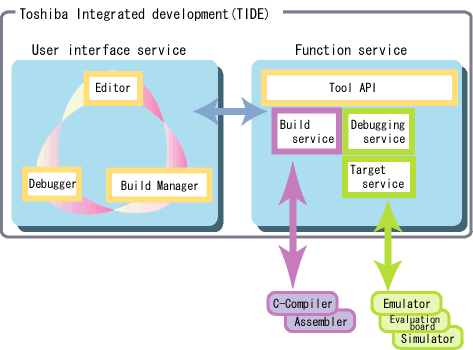
The build manager (compiler) and debugger operate in the TOSHIBA integrated development environment (IDE). Furthermore, installation of the standard text editor enables smooth linking from coding to debugging, effectively supporting application development.
Comfortable Development Environment Equivalent to Software Development Environment for Personal Computer
- Seamless Linking from Compilation to Debugging
Debugging can be readily started by operating only one button. The file to be compiled is automatically determined and, if necessary, compiled and linked to start the debugger. The user needs not to be aware of updating of the file.
- Capable of Correcting the Program Being Debugged
The program can be corrected in the Debug screen by using the built-in editor. Your favorite editor can be also built in for use.
- User-friendly User Interface
Provides excellent operability through GUI.
Build Feature
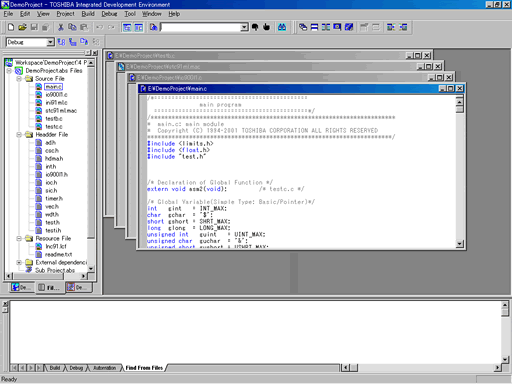
The TOSHIBA Integrated Development Environment improves development efficiency and provides user-friendly operability by linking the major development processes (coding, building, debugging) of the program. Freed from specifying the complicated options of the compiler or linkers and the requirement to master the commands, an application developer can concentrate on the development and quality improvement of the program itself. A development application is managed as a project.
- Options can be easily set by GUI.
Image of Build Manager
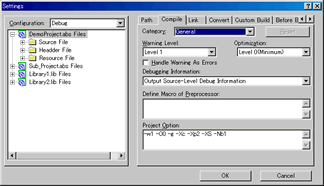
- Excellent operability is realized by GUI.
- Options can be easily set by GUI without the requirement to master option commands. Further, options can be easily switched over by setting plural configurations of options and changing them over.
- Capable of hierarchical control of projects.
- Capable of searching in the files.
- Dependency between projects can be visually shown.
Compile Option Setting Screen
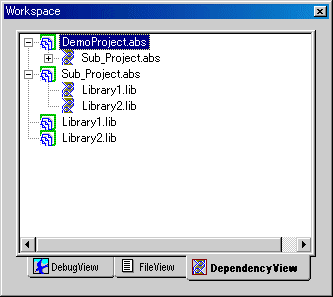
- An easy setting of compile option is realized by GUI operation.
Dependency View
- Dependency between projects is comprehensibly shown.
- Dependency between projects is configured by mouse operation.
Text Editor Feature
- Capable of not only coding, but correcting a program in the screen in the midst of debugging.
- Capable of searching in the files.
Debugger
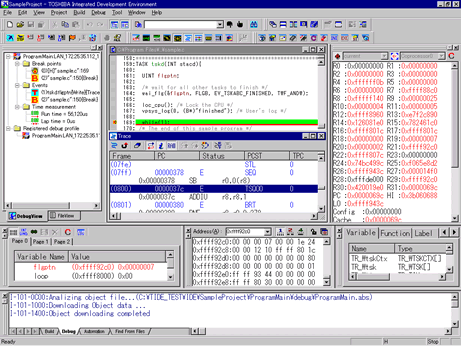
- Capable of directly editing the source code in the debugging.
- Capable of transferring the data between various debug features, allowing intuitive operation.
(Drag & drop feature)(Right-click allowed) - Capable of saving user's optional debugging environment to switch it for use.
(Profile feature) - Capable of debugging only in the PC environment by the simulator.
(Event trigger action feature)
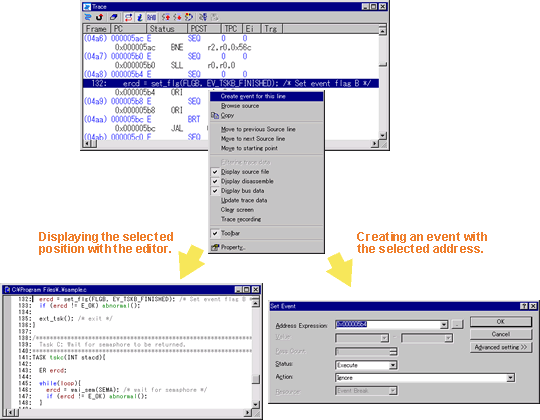
Example of Linking from the Trace Window to Each of the Windows
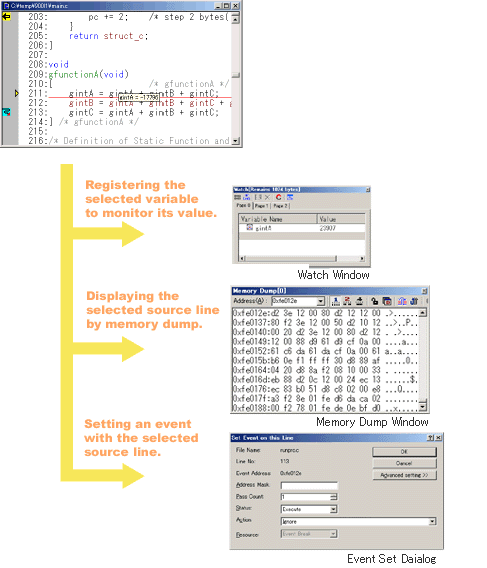
Example of Linking from the Editor to Each of the Windows
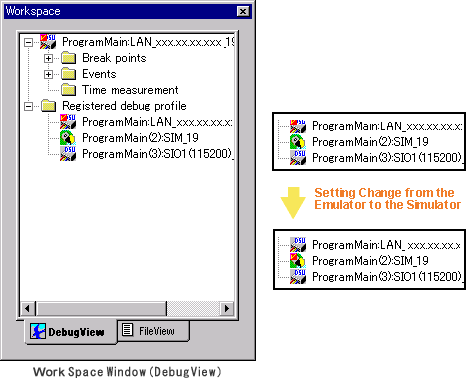
Profile Feature
Capable of saving multiple debugger setting files to switch them for use.
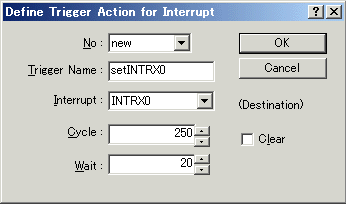
Event Trigger Action Feature
When the program is placed in a certain state (generation of an event), some action (trigger action) can be user-defined. The following lists the user-definable types of trigger actions.
- Interrupt
Capable of generating a periodic interrupt or multiinterrupt. The interrupt level register operates in the way identical to the actual machine. - Data Input
Capable of generating an optional data sequence or normal distribution random numbers to input them to an optional port. - Data Transfer
Capable of transferring the data from memory to memory, assuming the DMA. - I/O Stream
Capable of transferring the data to other application or reading the data from other application, using socket communication.
Example of Defining the Trigger Action Which Starts the Interrupt INTRTC in 20 Cycles after Generation of the Event at Period of 250 Cycles.
Hardware Products
3rd Party
The 3rd Party development tools are introduced.
FAQ
Answers to frequently asked questions on the microcomputer developing systems.